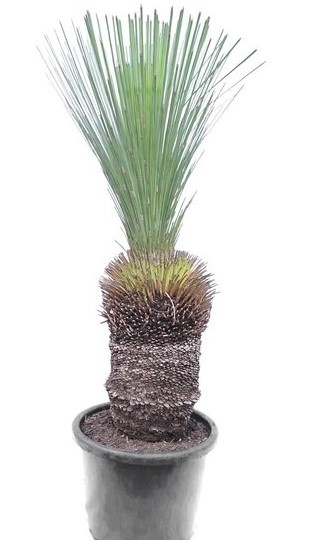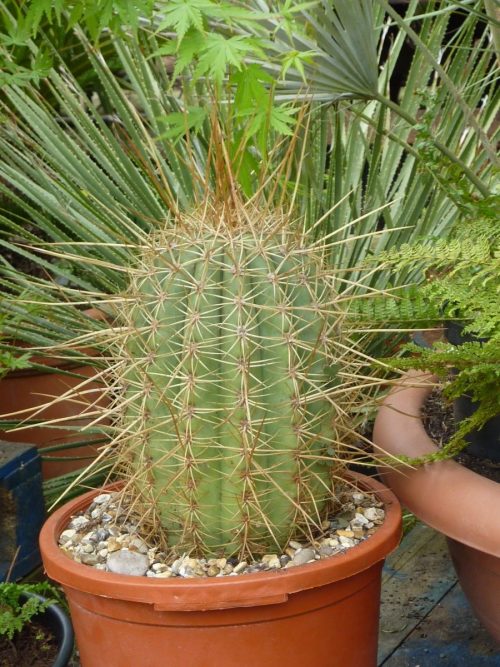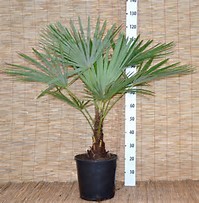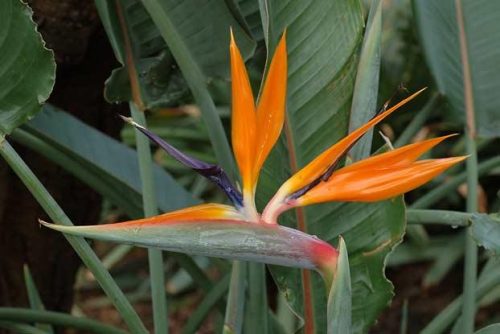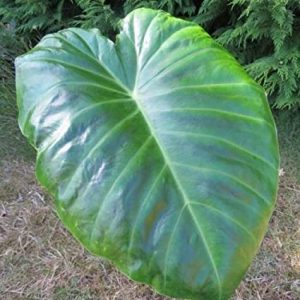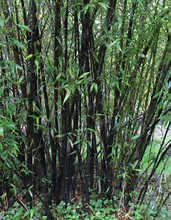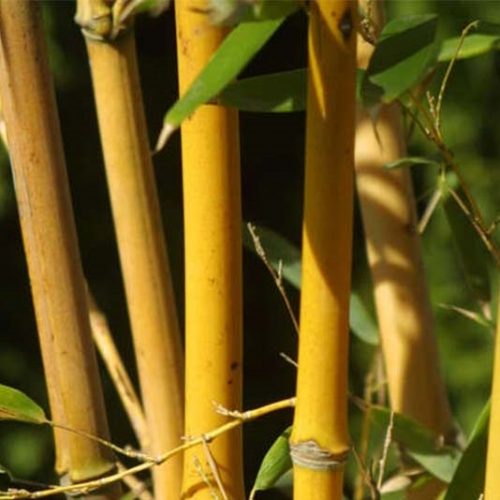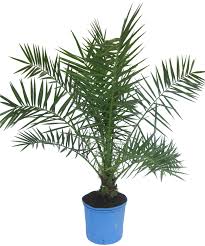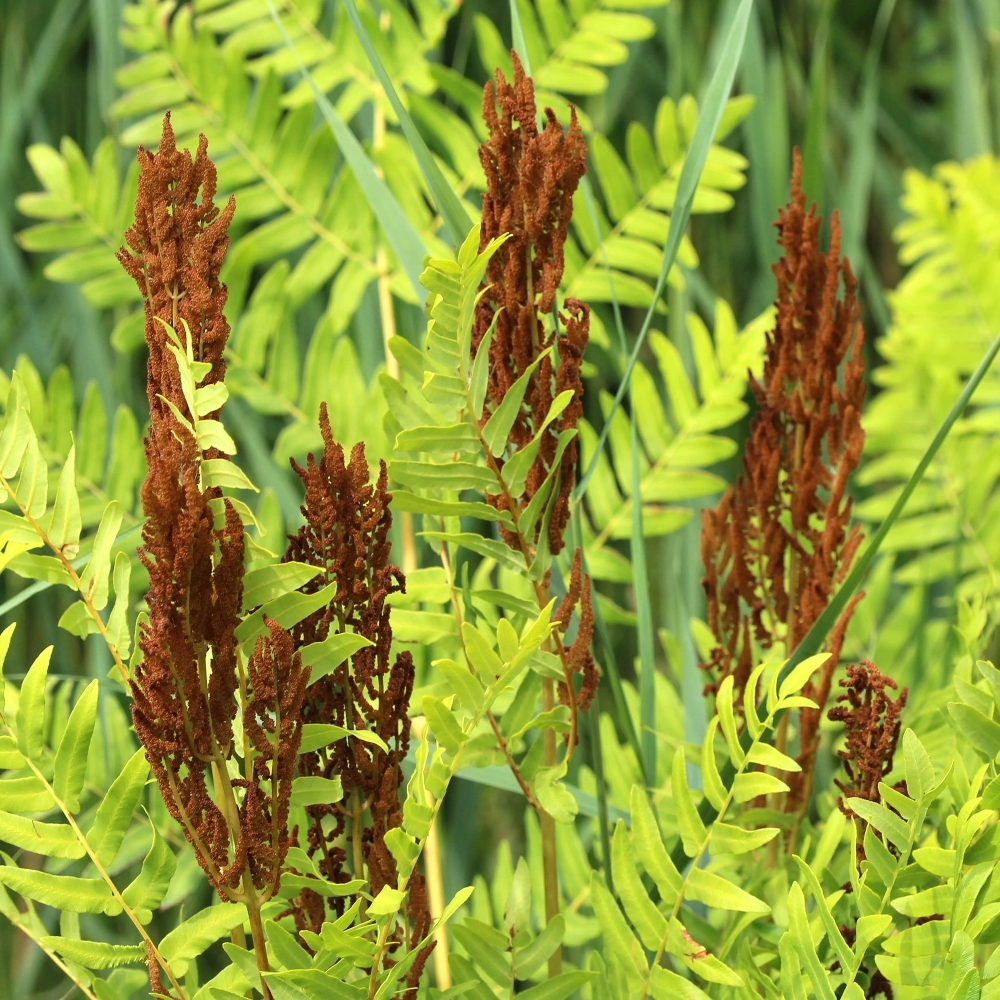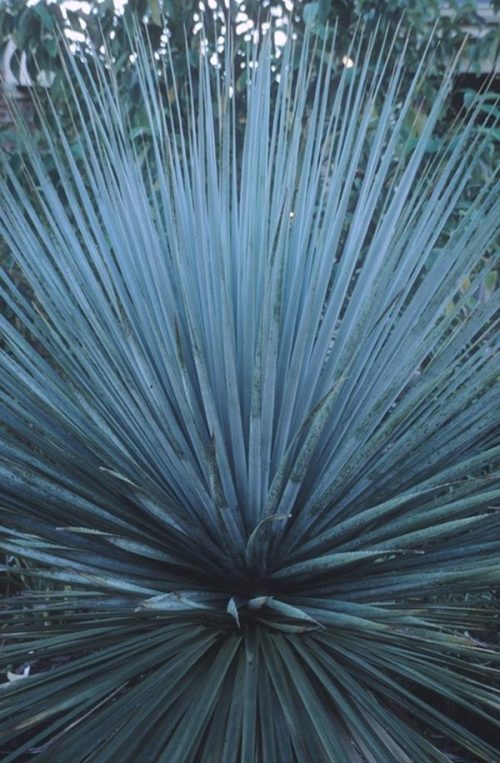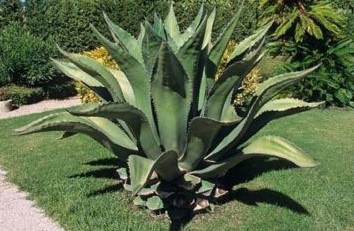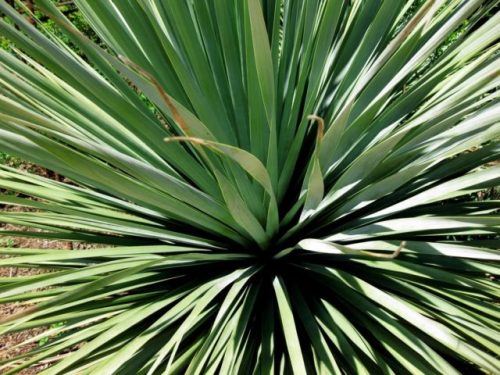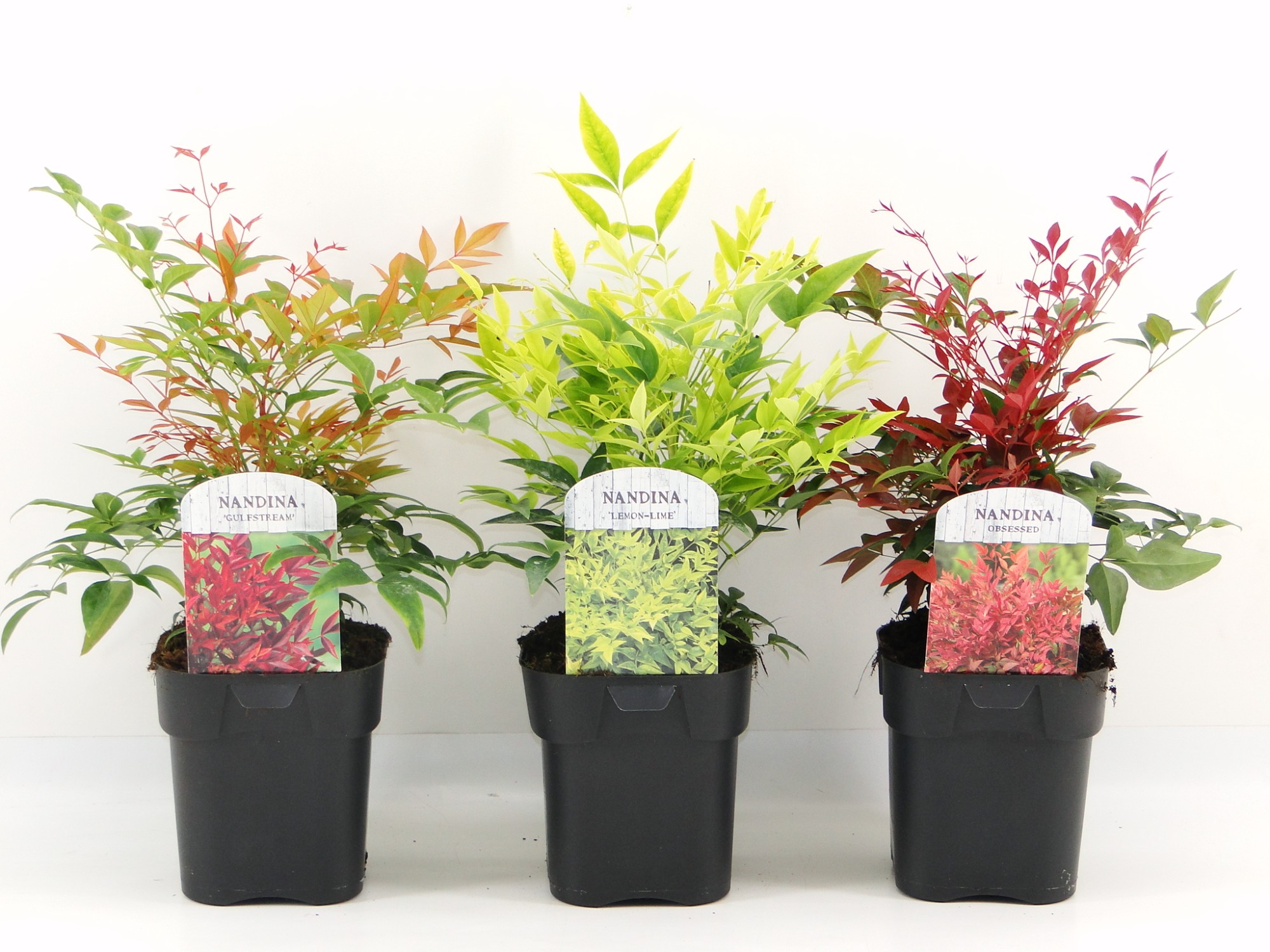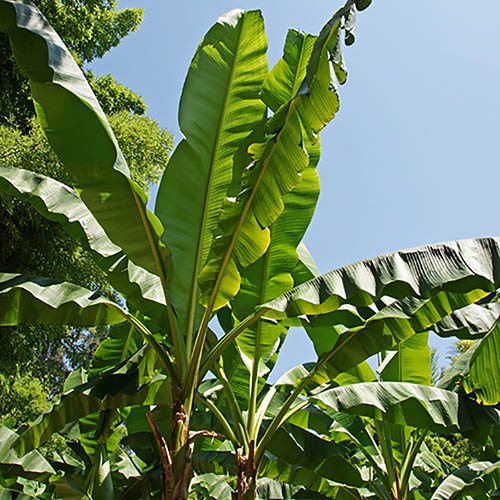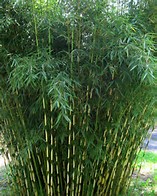-
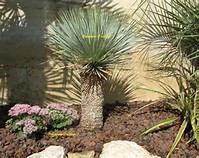
 A native to the Chihuahuan Desert, inhabits western Texas and northern Mexico in the states of Chihuahua and Coahuila. Yucca rostrata, or Beaked Yucca, is typically found growing on rocky bajadas, slopes, or ridges that are comprised of limestone gravel. Beaked Yucca is a single-trunked arborescent yucca that reaches heights of 6-15 feet. Mature plants may branch and become multi-headed
A native to the Chihuahuan Desert, inhabits western Texas and northern Mexico in the states of Chihuahua and Coahuila. Yucca rostrata, or Beaked Yucca, is typically found growing on rocky bajadas, slopes, or ridges that are comprised of limestone gravel. Beaked Yucca is a single-trunked arborescent yucca that reaches heights of 6-15 feet. Mature plants may branch and become multi-headed -
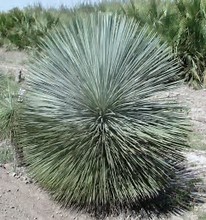 Yucca linearifolia ‘blue form’, also called Y.linearis. It has flexible, short green leaves up to 30-50 cm long, forming a perfectly spherical head. If through circumstances the base of the trunk is rotten, it can be cut off and the plant will make new roots via de outer trunk layer. Another remarkable quality is that if the crown is rotten you can treat it for mould and this plant will make new crowns. This plant can withstand temperatures down to -15 degrees Celsius.
Yucca linearifolia ‘blue form’, also called Y.linearis. It has flexible, short green leaves up to 30-50 cm long, forming a perfectly spherical head. If through circumstances the base of the trunk is rotten, it can be cut off and the plant will make new roots via de outer trunk layer. Another remarkable quality is that if the crown is rotten you can treat it for mould and this plant will make new crowns. This plant can withstand temperatures down to -15 degrees Celsius. -
 A large, upright shrub or small tree with several trunks growing from near ground level, sparsely branched. The stiff, leathery leaves are narrow, and up to 1m long. On mature plants flowering spikes up to 1m long appear in summer and autumn bearing large numbers of creamy-white, hanging flowers. Like bright areas in the garden or indoors, do not over water, it prefers to be dry, can cope with a degress of drought. Slow growing.
A large, upright shrub or small tree with several trunks growing from near ground level, sparsely branched. The stiff, leathery leaves are narrow, and up to 1m long. On mature plants flowering spikes up to 1m long appear in summer and autumn bearing large numbers of creamy-white, hanging flowers. Like bright areas in the garden or indoors, do not over water, it prefers to be dry, can cope with a degress of drought. Slow growing. -
 The papery flamboyant blooms and interesting foliage of tree peonies gives the impression that the plants are delicate. Thankfully, the complete opposite is true. Tree peonies are long-lived, hardy shrubs provided they are grown in a suitable spot. The common name is misleading as they are not trees but deciduous shrubs.
The papery flamboyant blooms and interesting foliage of tree peonies gives the impression that the plants are delicate. Thankfully, the complete opposite is true. Tree peonies are long-lived, hardy shrubs provided they are grown in a suitable spot. The common name is misleading as they are not trees but deciduous shrubs. -
 A new addition from Japan a fabulous architectural palm and perfect for the smaller garden. ‘Miniature’ is somewhat misleading as this relates to the stiff-leaves which even on mature tress are no more than a couple of feet across, half that of the Trachycarpus Fortunei. It is considerably more wind tolerant than its cousins and for this reason this is perfect on more exposed sites – a must for every garden.
A new addition from Japan a fabulous architectural palm and perfect for the smaller garden. ‘Miniature’ is somewhat misleading as this relates to the stiff-leaves which even on mature tress are no more than a couple of feet across, half that of the Trachycarpus Fortunei. It is considerably more wind tolerant than its cousins and for this reason this is perfect on more exposed sites – a must for every garden. -
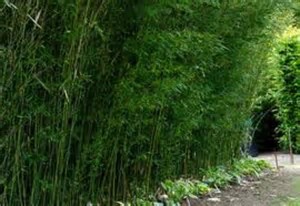 This is one of many Phyllostachys species that are superficially 'just' plain green but Phyllostachys bissetii stands out from the crowd because it excels at what it does - it is extremely hardy and tolerant. It is one of the freshest looking bamboos at winter's end - its thickly growing foliage and densely clustered canes are almost completely windproof, thereby making a perfect screening or hedging plant. Ultimately a running bamboo, Phyllostachys bissetii benefits from barrier protection although it can remain compact for some years before taking off.
This is one of many Phyllostachys species that are superficially 'just' plain green but Phyllostachys bissetii stands out from the crowd because it excels at what it does - it is extremely hardy and tolerant. It is one of the freshest looking bamboos at winter's end - its thickly growing foliage and densely clustered canes are almost completely windproof, thereby making a perfect screening or hedging plant. Ultimately a running bamboo, Phyllostachys bissetii benefits from barrier protection although it can remain compact for some years before taking off. -
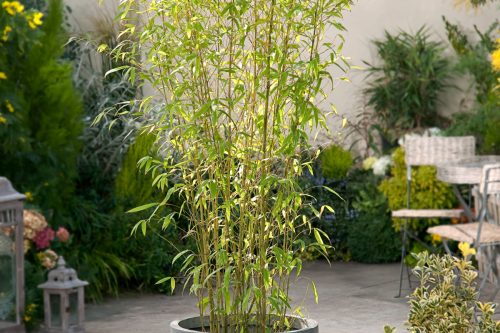 Phyllostachys Aurea (Yellow Bamboo) is originally from China and grows up to 4-6 m, it is clump forming and withstand -18c. The canes of Phyllostachys Aurea (Yellow Bamboo) are a soft yellow in the sun and olive green in the shade, excellent for hedging, screening, and isolated clumps or a potted specimen.
Phyllostachys Aurea (Yellow Bamboo) is originally from China and grows up to 4-6 m, it is clump forming and withstand -18c. The canes of Phyllostachys Aurea (Yellow Bamboo) are a soft yellow in the sun and olive green in the shade, excellent for hedging, screening, and isolated clumps or a potted specimen. -
Out of stock
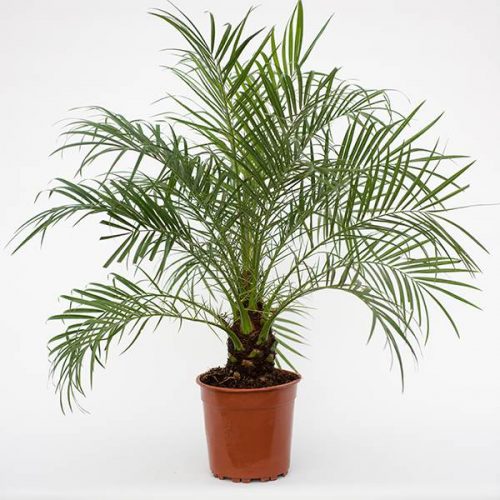 Phoenix is a dwarf palm with a slender trunk, occasionally clustered, bearing pinnately-divided leaves to 1m in length; panicles of small yellow flowers may be followed by small edible black fruit
Phoenix is a dwarf palm with a slender trunk, occasionally clustered, bearing pinnately-divided leaves to 1m in length; panicles of small yellow flowers may be followed by small edible black fruit -
Out of stock
 A genus of a single species closely related to Cyathea, but is not a true tree fern. Is a native to the Americas from Cuba to Mexico down to southern Chile. A soft foliage with large graceful fronds to 6’ long and blueish silver glaucous beneath makes this a beautiful dramatic fern and a focal point in any garden.
A genus of a single species closely related to Cyathea, but is not a true tree fern. Is a native to the Americas from Cuba to Mexico down to southern Chile. A soft foliage with large graceful fronds to 6’ long and blueish silver glaucous beneath makes this a beautiful dramatic fern and a focal point in any garden. -
Out of stock
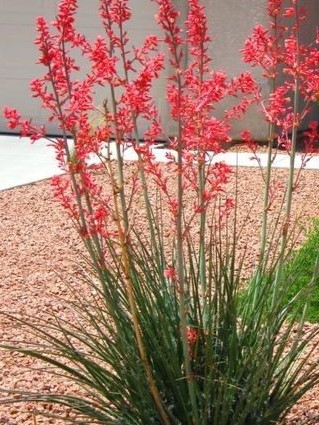
 Drought tolerant, heat resistant, severe frost resilient, low maintenance and the architectural shape makes this plant a wonderful addition to the tropical, exotic, desert or rock garden. Hesperaloes are also well suited for the container or planter culture for the Patio or the Balcony
Drought tolerant, heat resistant, severe frost resilient, low maintenance and the architectural shape makes this plant a wonderful addition to the tropical, exotic, desert or rock garden. Hesperaloes are also well suited for the container or planter culture for the Patio or the Balcony -
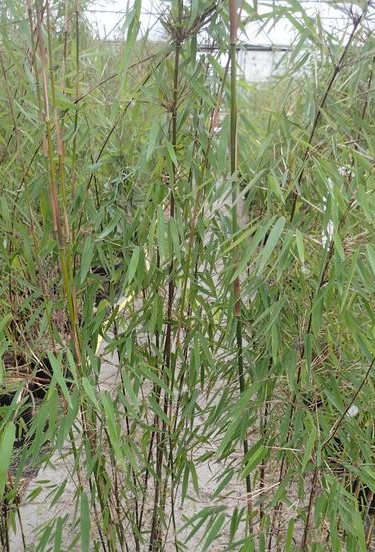 A colourful elegant small leafed bamboo which in spring can turn erect culms red. This is a new generation of bamboo from China. Ideal as a specimen or for creating a dense hedge, grows up to 2-3 metres. 3 litre pots £24.50, 7.5 lite pots £34.50, Fargesia Information: In the twenty century Fargesia nitida and murieliae were the only two Fargesias varieties available in this country. They were perfect for small gardens, giving the touch of the oriental ambiance, clump forming, evergreen and non-invasive, suitable to be planted as a hedge, in large pots or as a specimen planted out. Bamboo itself has a hidden nick name called ‘Century‘ plant as it due to flower once in a century, a building DNA stimulates other bamboo of same genre to flower around the world at the same period, after years of seed production most mother plant will die. In the nineteen nineties both types of Fargesia entered their flowering period at the same time this produced over the years an abundance and high excess of seedlings in their native China. To replenish the dying stock of Fargesia, collectors, Nursery men and Botanist flooded to China collecting seedlings by the thousands. Over the years the Fargesia off spring showed a high number of variation with lots of inferior inbred plants. Twenty years on, Dutch plant breeders where able to produce artificial crosses between Fargesia and different clones of nitida to produce some extremely beautiful hybrids.
A colourful elegant small leafed bamboo which in spring can turn erect culms red. This is a new generation of bamboo from China. Ideal as a specimen or for creating a dense hedge, grows up to 2-3 metres. 3 litre pots £24.50, 7.5 lite pots £34.50, Fargesia Information: In the twenty century Fargesia nitida and murieliae were the only two Fargesias varieties available in this country. They were perfect for small gardens, giving the touch of the oriental ambiance, clump forming, evergreen and non-invasive, suitable to be planted as a hedge, in large pots or as a specimen planted out. Bamboo itself has a hidden nick name called ‘Century‘ plant as it due to flower once in a century, a building DNA stimulates other bamboo of same genre to flower around the world at the same period, after years of seed production most mother plant will die. In the nineteen nineties both types of Fargesia entered their flowering period at the same time this produced over the years an abundance and high excess of seedlings in their native China. To replenish the dying stock of Fargesia, collectors, Nursery men and Botanist flooded to China collecting seedlings by the thousands. Over the years the Fargesia off spring showed a high number of variation with lots of inferior inbred plants. Twenty years on, Dutch plant breeders where able to produce artificial crosses between Fargesia and different clones of nitida to produce some extremely beautiful hybrids. -
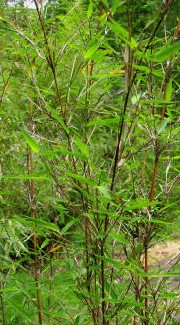 This is a rare form of Jiuzhaigou which was collected as a seedling from Jiuhaigou Park in northern Sichuan China. The canes are of reddish colour with fine foliage. Currently still a fairly new cultivar and quite rare.Bamboo Information: In the twenty century Fargesia nitida and murieliae were the only two Fargesias varieties available in this country. They were perfect for small gardens, giving the touch of the oriental ambiance, clump forming, evergreen and non-invasive, suitable to be planted as a hedge, in large pots or as a specimen planted out. Bamboo itself has a hidden nick name called ‘Century‘ plant as it due to flower once in a century, a building DNA stimulates other bamboo of same genre to flower around the world at the same period, after years of seed production most mother plant will die. In the nineteen nineties both types of Fargesia entered their flowering period at the same time this produced over the years an abundance and high excess of seedlings in their native China. To replenish the dying stock of Fargesia, collectors, Nursery men and Botanist flooded to China collecting seedlings by the thousands. Over the years the Fargesia off spring showed a high number of variation with lots of inferior inbred plants. Twenty years on, Dutch plant breeders where able to produce artificial crosses between Fargesia and different clones of nitida to produce some extremely beautiful hybrids.
This is a rare form of Jiuzhaigou which was collected as a seedling from Jiuhaigou Park in northern Sichuan China. The canes are of reddish colour with fine foliage. Currently still a fairly new cultivar and quite rare.Bamboo Information: In the twenty century Fargesia nitida and murieliae were the only two Fargesias varieties available in this country. They were perfect for small gardens, giving the touch of the oriental ambiance, clump forming, evergreen and non-invasive, suitable to be planted as a hedge, in large pots or as a specimen planted out. Bamboo itself has a hidden nick name called ‘Century‘ plant as it due to flower once in a century, a building DNA stimulates other bamboo of same genre to flower around the world at the same period, after years of seed production most mother plant will die. In the nineteen nineties both types of Fargesia entered their flowering period at the same time this produced over the years an abundance and high excess of seedlings in their native China. To replenish the dying stock of Fargesia, collectors, Nursery men and Botanist flooded to China collecting seedlings by the thousands. Over the years the Fargesia off spring showed a high number of variation with lots of inferior inbred plants. Twenty years on, Dutch plant breeders where able to produce artificial crosses between Fargesia and different clones of nitida to produce some extremely beautiful hybrids. -
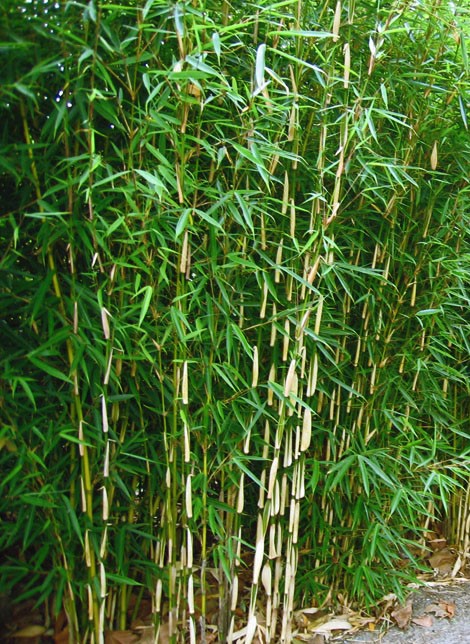 This bamboo is beautiful in appearance with erect and compact growth habit. Evergreen with small shiny leaves, contrasting with white culm sheaths and deep green canes. Plant Information: In the twenty century Fargesia nitida and murieliae were the only two Fargesias varieties available in this country. They were perfect for small gardens, giving the touch of the oriental ambiance, clump forming, evergreen and non-invasive, suitable to be planted as a hedge, in large pots or as a specimen planted out. Bamboo itself has a hidden nick name called ‘Century‘ plant as it due to flower once in a century, a building DNA stimulates other bamboo of same genre to flower around the world at the same period, after years of seed production most mother plant will die. In the nineteen nineties both types of Fargesia entered their flowering period at the same time this produced over the years an abundance and high excess of seedlings in their native China. To replenish the dying stock of Fargesia, collectors, Nursery men and Botanist flooded to China collecting seedlings by the thousands. Over the years the Fargesia off spring showed a high number of variation with lots of inferior inbred plants. Twenty years on, Dutch plant breeders where able to produce artificial crosses between Fargesia and different clones of nitida to produce some extremely beautiful hybrids.
This bamboo is beautiful in appearance with erect and compact growth habit. Evergreen with small shiny leaves, contrasting with white culm sheaths and deep green canes. Plant Information: In the twenty century Fargesia nitida and murieliae were the only two Fargesias varieties available in this country. They were perfect for small gardens, giving the touch of the oriental ambiance, clump forming, evergreen and non-invasive, suitable to be planted as a hedge, in large pots or as a specimen planted out. Bamboo itself has a hidden nick name called ‘Century‘ plant as it due to flower once in a century, a building DNA stimulates other bamboo of same genre to flower around the world at the same period, after years of seed production most mother plant will die. In the nineteen nineties both types of Fargesia entered their flowering period at the same time this produced over the years an abundance and high excess of seedlings in their native China. To replenish the dying stock of Fargesia, collectors, Nursery men and Botanist flooded to China collecting seedlings by the thousands. Over the years the Fargesia off spring showed a high number of variation with lots of inferior inbred plants. Twenty years on, Dutch plant breeders where able to produce artificial crosses between Fargesia and different clones of nitida to produce some extremely beautiful hybrids. -
Out of stock
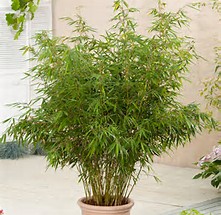 Pingwu is non-invasive garden bamboo with erect growth habit. The new shoots develop already early in spring. The geometric pattern of the white coloured culm sheaths against the green background of the new developing shoots is really spectacular.
Pingwu is non-invasive garden bamboo with erect growth habit. The new shoots develop already early in spring. The geometric pattern of the white coloured culm sheaths against the green background of the new developing shoots is really spectacular. -
 The 'Shadow Light' is a low growing Fargesia with black canes, originating from a selection of seedlings in 2004, best suited for a spot in the (semi) shade, Plant Information: In the twenty century Fargesia nitida and murieliae were the only two Fargesias varieties available in this country. They were perfect for small gardens, giving the touch of the oriental ambiance, clump forming, evergreen and non-invasive, suitable to be planted as a hedge, in large pots or as a specimen planted out. Bamboo itself has a hidden nick name called ‘Century‘ plant as it due to flower once in a century, a building DNA stimulates other bamboo of same genre to flower around the world at the same period, after years of seed production most mother plant will die. In the nineteen nineties both types of Fargesia entered their flowering period at the same time this produced over the years an abundance and high excess of seedlings in their native China. To replenish the dying stock of Fargesia, collectors, Nursery men and Botanist flooded to China collecting seedlings by the thousands. Over the years the Fargesia off spring showed a high number of variation with lots of inferior inbred plants. Twenty years on, Dutch plant breeders where able to produce artificial crosses between Fargesia and different clones of nitida to produce some extremely beautiful hybrids.
The 'Shadow Light' is a low growing Fargesia with black canes, originating from a selection of seedlings in 2004, best suited for a spot in the (semi) shade, Plant Information: In the twenty century Fargesia nitida and murieliae were the only two Fargesias varieties available in this country. They were perfect for small gardens, giving the touch of the oriental ambiance, clump forming, evergreen and non-invasive, suitable to be planted as a hedge, in large pots or as a specimen planted out. Bamboo itself has a hidden nick name called ‘Century‘ plant as it due to flower once in a century, a building DNA stimulates other bamboo of same genre to flower around the world at the same period, after years of seed production most mother plant will die. In the nineteen nineties both types of Fargesia entered their flowering period at the same time this produced over the years an abundance and high excess of seedlings in their native China. To replenish the dying stock of Fargesia, collectors, Nursery men and Botanist flooded to China collecting seedlings by the thousands. Over the years the Fargesia off spring showed a high number of variation with lots of inferior inbred plants. Twenty years on, Dutch plant breeders where able to produce artificial crosses between Fargesia and different clones of nitida to produce some extremely beautiful hybrids. -
Out of stock
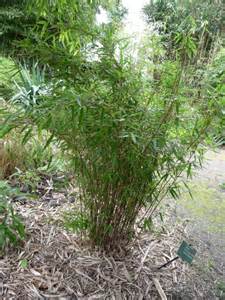 These architectural plants have stunning stem structure and delightful evergreen foliage. They are easy to grow, needing minimum maintenance, and thrive in all soils.
These architectural plants have stunning stem structure and delightful evergreen foliage. They are easy to grow, needing minimum maintenance, and thrive in all soils. -
 This Fargesia is a new generation non-invasive bamboo with an extradinary vitality. Grows up to 3 metres. 7.5 litre pots. In the twenty century Fargesia nitida and murieliae were the only two Fargesias varieties available in this country. They were perfect for small gardens, giving the touch of the oriental ambiance, clump forming, evergreen and non-invasive, suitable to be planted as a hedge, in large pots or as a specimen planted out. Bamboo itself has a hidden nick name called ‘Century‘ plant as it due to flower once in a century, a building DNA stimulates other bamboo of same genre to flower around the world at the same period, after years of seed production most mother plant will die. In the nineteen nineties both types of Fargesia entered their flowering period at the same time this produced over the years an abundance and high excess of seedlings in their native China. To replenish the dying stock of Fargesia, collectors, Nursery men and Botanist flooded to China collecting seedlings by the thousands. Over the years the Fargesia off spring showed a high number of variation with lots of inferior inbred plants. Twenty years on, Dutch plant breeders where able to produce artificial crosses between Fargesia and different clones of nitida to produce some extremely beautiful hybrids.
This Fargesia is a new generation non-invasive bamboo with an extradinary vitality. Grows up to 3 metres. 7.5 litre pots. In the twenty century Fargesia nitida and murieliae were the only two Fargesias varieties available in this country. They were perfect for small gardens, giving the touch of the oriental ambiance, clump forming, evergreen and non-invasive, suitable to be planted as a hedge, in large pots or as a specimen planted out. Bamboo itself has a hidden nick name called ‘Century‘ plant as it due to flower once in a century, a building DNA stimulates other bamboo of same genre to flower around the world at the same period, after years of seed production most mother plant will die. In the nineteen nineties both types of Fargesia entered their flowering period at the same time this produced over the years an abundance and high excess of seedlings in their native China. To replenish the dying stock of Fargesia, collectors, Nursery men and Botanist flooded to China collecting seedlings by the thousands. Over the years the Fargesia off spring showed a high number of variation with lots of inferior inbred plants. Twenty years on, Dutch plant breeders where able to produce artificial crosses between Fargesia and different clones of nitida to produce some extremely beautiful hybrids. -
Out of stock
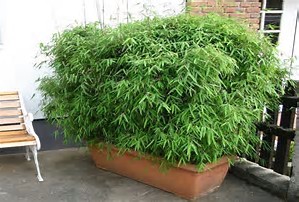 The Great Wall is a new highly ornamental garden bamboo. It has an erect growth habit and is a clumping bamboo, because of this, there is no need for rhizome barriers. This seedling is a selection from a botanical garden on the Isle of Man.
The Great Wall is a new highly ornamental garden bamboo. It has an erect growth habit and is a clumping bamboo, because of this, there is no need for rhizome barriers. This seedling is a selection from a botanical garden on the Isle of Man. -
 This colourful bamboo is evergreen and very hardy. It produces no runners and is therefore not invasive. In the summer it produces beautiful purple shoots, in winter it fades to black. Ideal as a specimen or a dense hedge in dappled shade. Grows to 2.5 metres . 7.5 litre pots £34.50. Bamboo Information In the twenty century Fargesia nitida and murieliae were the only two Fargesias varieties available in this country. They were perfect for small gardens, giving the touch of the oriental ambiance, clump forming, evergreen and non-invasive, suitable to be planted as a hedge, in large pots or as a specimen planted out. Bamboo itself has a hidden nick name called ‘Century‘ plant as it due to flower once in a century, a building DNA stimulates other bamboo of same genre to flower around the world at the same period, after years of seed production most mother plant will die. In the nineteen nineties both types of Fargesia entered their flowering period at the same time this produced over the years an abundance and high excess of seedlings in their native China. To replenish the dying stock of Fargesia, collectors, Nursery men and Botanist flooded to China collecting seedlings by the thousands. Over the years the Fargesia off spring showed a high number of variation with lots of inferior inbred plants. Twenty years on, Dutch plant breeders where able to produce artificial crosses between Fargesia and different clones of nitida to produce some extremely beautiful hybrids.
This colourful bamboo is evergreen and very hardy. It produces no runners and is therefore not invasive. In the summer it produces beautiful purple shoots, in winter it fades to black. Ideal as a specimen or a dense hedge in dappled shade. Grows to 2.5 metres . 7.5 litre pots £34.50. Bamboo Information In the twenty century Fargesia nitida and murieliae were the only two Fargesias varieties available in this country. They were perfect for small gardens, giving the touch of the oriental ambiance, clump forming, evergreen and non-invasive, suitable to be planted as a hedge, in large pots or as a specimen planted out. Bamboo itself has a hidden nick name called ‘Century‘ plant as it due to flower once in a century, a building DNA stimulates other bamboo of same genre to flower around the world at the same period, after years of seed production most mother plant will die. In the nineteen nineties both types of Fargesia entered their flowering period at the same time this produced over the years an abundance and high excess of seedlings in their native China. To replenish the dying stock of Fargesia, collectors, Nursery men and Botanist flooded to China collecting seedlings by the thousands. Over the years the Fargesia off spring showed a high number of variation with lots of inferior inbred plants. Twenty years on, Dutch plant breeders where able to produce artificial crosses between Fargesia and different clones of nitida to produce some extremely beautiful hybrids. -
Out of stock
 The Fargesia nitida bamboo is an elegant forming a compact clump of erect to arching, purple-flushed green canes to 2 m high, with slender dark green leaves. This bamboo is clump forming and non invasive, can take full sun. 3 litre pots £22.50. Bamboo Information: In the twenty century Fargesia nitida and murieliae were the only two Fargesias varieties available in this country. They were perfect for small gardens, giving the touch of the oriental ambiance, clump forming, evergreen and non-invasive, suitable to be planted as a hedge, in large pots or as a specimen planted out. Bamboo itself has a hidden nick name called ‘Century‘ plant as it due to flower once in a century, a building DNA stimulates other bamboo of same genre to flower around the world at the same period, after years of seed production most mother plant will die. In the nineteen nineties both types of Fargesia entered their flowering period at the same time this produced over the years an abundance and high excess of seedlings in their native China. To replenish the dying stock of Fargesia, collectors, Nursery men and Botanist flooded to China collecting seedlings by the thousands. Over the years the Fargesia off spring showed a high number of variation with lots of inferior inbred plants. Twenty years on, Dutch plant breeders where able to produce artificial crosses between Fargesia and different clones of nitida to produce some extremely beautiful hybrids.
The Fargesia nitida bamboo is an elegant forming a compact clump of erect to arching, purple-flushed green canes to 2 m high, with slender dark green leaves. This bamboo is clump forming and non invasive, can take full sun. 3 litre pots £22.50. Bamboo Information: In the twenty century Fargesia nitida and murieliae were the only two Fargesias varieties available in this country. They were perfect for small gardens, giving the touch of the oriental ambiance, clump forming, evergreen and non-invasive, suitable to be planted as a hedge, in large pots or as a specimen planted out. Bamboo itself has a hidden nick name called ‘Century‘ plant as it due to flower once in a century, a building DNA stimulates other bamboo of same genre to flower around the world at the same period, after years of seed production most mother plant will die. In the nineteen nineties both types of Fargesia entered their flowering period at the same time this produced over the years an abundance and high excess of seedlings in their native China. To replenish the dying stock of Fargesia, collectors, Nursery men and Botanist flooded to China collecting seedlings by the thousands. Over the years the Fargesia off spring showed a high number of variation with lots of inferior inbred plants. Twenty years on, Dutch plant breeders where able to produce artificial crosses between Fargesia and different clones of nitida to produce some extremely beautiful hybrids. -
 The Fargesia murieliae 'Lava' has bright blue-green leaves with yellow-green canes. Grows to height of 1.5 cm Plant in well drained soil in full sun or partly shady spot. Bamboo Information In the twenty century Fargesia nitida and murieliae were the only two Fargesias varieties available in this country. They were perfect for small gardens, giving the touch of the oriental ambiance, clump forming, evergreen and non-invasive, suitable to be planted as a hedge, in large pots or as a specimen planted out. Bamboo itself has a hidden nick name called ‘Century‘ plant as it due to flower once in a century, a building DNA stimulates other bamboo of same genre to flower around the world at the same period, after years of seed production most mother plant will die. In the nineteen nineties both types of Fargesia entered their flowering period at the same time this produced over the years an abundance and high excess of seedlings in their native China. To replenish the dying stock of Fargesia, collectors, Nursery men and Botanist flooded to China collecting seedlings by the thousands. Over the years the Fargesia off spring showed a high number of variation with lots of inferior inbred plants. Twenty years on, Dutch plant breeders where able to produce artificial crosses between Fargesia and different clones of nitida to produce some extremely beautiful hybrids.
The Fargesia murieliae 'Lava' has bright blue-green leaves with yellow-green canes. Grows to height of 1.5 cm Plant in well drained soil in full sun or partly shady spot. Bamboo Information In the twenty century Fargesia nitida and murieliae were the only two Fargesias varieties available in this country. They were perfect for small gardens, giving the touch of the oriental ambiance, clump forming, evergreen and non-invasive, suitable to be planted as a hedge, in large pots or as a specimen planted out. Bamboo itself has a hidden nick name called ‘Century‘ plant as it due to flower once in a century, a building DNA stimulates other bamboo of same genre to flower around the world at the same period, after years of seed production most mother plant will die. In the nineteen nineties both types of Fargesia entered their flowering period at the same time this produced over the years an abundance and high excess of seedlings in their native China. To replenish the dying stock of Fargesia, collectors, Nursery men and Botanist flooded to China collecting seedlings by the thousands. Over the years the Fargesia off spring showed a high number of variation with lots of inferior inbred plants. Twenty years on, Dutch plant breeders where able to produce artificial crosses between Fargesia and different clones of nitida to produce some extremely beautiful hybrids.



